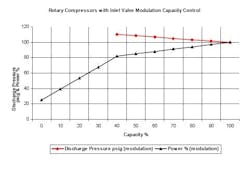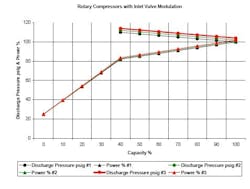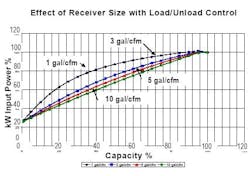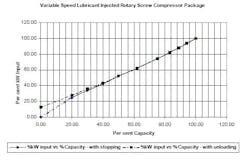The type of compressor capacity control you use and the related pressure settings you select are critical to your overall compressed air system efficiency. For years, many rotary compressors were sold with inlet valve modulation (throttling) as the standard means of capacity control. While this matched compressor output with demand, the system offered much less than desirable energy efficiency.
However, there are ways to improve things.
In many plants, compressed air production started with one compressor. Then, as demand increased, another compressor was added and then another. For example, consider a system having three rotary compressors, each using inlet valve modulation capacity control.
The base case
Typically, the first compressor would have a discharge pressure control range of 100 psig to 110 psig, with full capacity at 100 psig and modulation down to 40% capacity at 100 psig, at which point it unloads.
If all three units had the same discharge pressure control range, they would simultaneously reduce capacity at the same rate, which is inefficient operation (Figure 1).
Often, the settings are staggered within a limited range to avoid a high overall pressure range. Ideally, the pressure settings would be reduced. However, if 100 psig is the minimum desired operating pressure, let’s arrange compressor 1 to operate in the range from 100 psig to 110 psig, compressor 2 from 102 psig to 112 psig and compressor 3 from 104 psig to 114 psig. Assume that the compressors and their drive motors are capable of operating at these upper pressure ranges (Figure 2).
As demand decreases and system pressure rises from 100 psig to 102 psig, compressor 1 modulates to about 88% capacity and a power requirement of 96%. Compressors 2 and 3 remain at 100% capacity and 101% power because of the increased pressure. This gives a total capacity of 96% and a total power requirement of 99.3%. At this point, compressor 2 is on the verge of modulating.
As demand further decreases, pressure will continue to rise. Compressor 1 will modulate more deeply and compressor 2 now starts to modulate. At 104 psig, compressor 1 is at 76% capacity and 92.8% power, while compressor 2 is at 88% capacity and 94.3% power. Just before compressor 3 starts to modulate, it will be at 100% capacity and at 102% power because of the increased pressure. Now, the total compressor capacity is 88% and total compressor power requirement is 96.4%.
If demand continues to fall and discharge pressure increases to 106 psig, compressor 1 goes to 64% capacity and 86.2% power, while compressor 2 is at 76% capacity and 92% power. Compressor 3 has modulated to 82% capacity and 96.5% power. This represents a total compressor capacity of 74% and a total compressor power of 91.6%.
Immediately before the discharge pressure reaches 110 psig, compressor 1 will be at 40% capacity and 82% power, compressor 2 will be at 52% capacity and 86.5% power, while compressor 3 will be at 64% capacity and 92.8% power. This yields a total compressor capacity of 52% with a total power requirement of 87.1%. Obviously this isn’t an efficient, or recommended, means of operation.
If demand continues to decline, compressor 1 unloads, reducing the total compressor capacity from 60% to the combined capacity of compressors 2 and 3, or 46.7%. This could cause compressor 2 and compressor 3 to modulate less if the system capacity requirement is higher than 46.7%.
Make it better
How can this system be improved? Note that the power requirement increases by 1% for every 2 psi increase in compressor discharge pressure. Optimum energy efficiency suggests that the compressor discharge pressure(s) and downstream system pressure be at their lowest practical setting. Assuming the end-use devices can operate satisfactorily at the lower pressure, this could mean a compressor 1 discharge range of 90 psig to 100 psig, instead of 100 psig to 110 psig, 2 compressor at 92 psig to 102 psig and 3 at 94 psig to 104 psig. This alone would reduce power consumption by 5%.
Generally speaking, only one compressor should be in modulation mode. The other two ought to be base-loaded (load/unload), without modulation. Then, they could still have a discharge pressure control range of 10 psi, with unloading at the higher pressure setting and reloading at the lower pressure setting. However, the compressor and its driver must be capable of operating at full capacity at the higher discharge pressure setting.
If compressor 2 and compressor 3 were in the load/unload mode, compressor 1 could modulate from 100% to 40%, giving a total compressor capacity range of 100% to 80% with a total compressor power range of 100% to 92.7%, but with only a slight improvement in total power. Compressor 2 and compressor 3 would run at 100% capacity and their power requirement would increase by 1% for every 2 psi increase in discharge pressure, while the modulating compressor discharge pressure would rise from 100 psig at 100% capacity to 110 psig at 40% capacity, just before it unloads. Increased discharge and system pressure both increase the rate of unregulated usage and leaks. This reality requires greater capacity (12% more at 114 psig compared with 100 psig) and power (7% higher at 114 psig compared with 100 psig).
Because compressor efficiency under load/unload capacity control depends on system storage capacity, you’ll need to have an adequately sized primary air receiver (Figure 3).
Smooth changes
Powering one of the three compressors with a variable-speed drive (VSD) would hold the discharge pressure to within 1 psi of the 100-psi setpoint. The other compressors would be on load/unload capacity control in response to a relatively constant minimum discharge pressure of 100 psig. This alone provides a significant reduction in total compressor power requirement, compared with operating between 100 psig and 114 psig with the 7% greater power requirement.
Now, as demand decreases, the VSD compressor reduces its speed and capacity yielding significant energy reduction (Figure 4). Some VSD compressors can reduce speed and capacity to 40% before unloading, while others reduce speed and capacity to about 20% before unloading (as indicated by the dotted lines). With capacity reduced to about 20%, the power requirement drops to about 26%. The other two compressors running at 100% capacity and 100 psig discharge pressure provide a total compressor capacity of 73.3% with a total compressor power of 75.3%. This is a substantial improvement in energy efficiency compared to the initial system.
Arrange the controls so that when the VSD compressor reaches its lower limit of 20% speed and capacity, one of the other compressors would unload and the VSD would adjust its capacity to provide the required capacity at the same controlled discharge pressure. If you do this, the VSD compressor must be sized so that its control range is at least equal to the full load capacity of each of the constant-speed compressors. This prevents a potential “control gap” when the VSD compressor unloads or stops, requiring the constant-speed compressor(s) to meet the system demand.
David M. McCulloch is president of Mac Consulting Services, Pittsboro, N.C. Contact him at [email protected] and (919) 542-6550.




